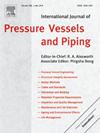基于复合磁场的异种钢焊缝熔合调节机理研究
IF 3
2区 工程技术
Q2 ENGINEERING, MECHANICAL
International Journal of Pressure Vessels and Piping
Pub Date : 2025-02-12
DOI:10.1016/j.ijpvp.2025.105464
引用次数: 0
摘要
由于材料力学和物理性能的显著差异,低合金钢/不锈钢气体钨极电弧焊(GTAW)接头存在熔透不全、开裂等焊接质量问题,这些问题是由母材熔合比变化较大引起的。为了解决这一问题,本研究通过电弧行为、焊缝形成和显微组织演变,研究了复合磁场法(纵向磁场(LMF) +尖端磁场(CMF))对Q345/316L异种金属焊缝母材熔合率的调节机制。讨论了焊透不全等焊缝缺陷的抑制方法。研究发现,复合磁场辅助异种钢焊接可有效控制母材熔合比,有效避免焊透不全导致的缺陷,显著提高异种钢焊接质量。与无外加磁场时相比,随着激励电流的增大,异种钢FRQ345焊缝中Q345的熔合率由34.15%逐渐降低到11.99%;基本金属frbm的熔合率从46.55%逐渐降低到26.55%;焊缝金属中脆性相马氏体含量逐渐降低,残余奥氏体含量显著增加。复合磁场作用下,枝晶臂间距(DAS)明显减小,细化程度在32.58% ~ 46.83%之间。研究结果为异种钢焊接中的热能调节提供了指导,为提高材料性能不对称的异种金属的焊接质量提供了新的解决方案。本文章由计算机程序翻译,如有差异,请以英文原文为准。
Research on fusion regulation mechanism of dissimilar steel welds based on compound magnetic field
Due to significant differences in the mechanical and physical properties of materials, low-alloy steel/stainless-steel joints by gas tungsten arc welding (GTAW) have welding quality problems such as incomplete penetration and cracking, which are caused by large variations in base metal fusion ratio. To address such issues, in this study, the effect of the regulation mechanism by a compound magnetic field approach (longitudinal magnetic field (LMF) + cusp magnetic field (CMF)) on the base metal fusion ratio in Q345/316L dissimilar metal welds was investigated, through arc behavior, weld formation, and microstructure evolution. The suppression methods of weld defects such as incomplete penetration are also discussed. It was found that compound magnetic field-assisted dissimilar steel welding can be used to control the base metal fusion ratio, effectively avoid defects due to incomplete weld penetration, and significantly improve the quality of dissimilar steel weldments. Compared with the sample without external magnetic field (EMF), as the exciting currents increased, the fusion ratio of Q345 in the dissimilar steel weld FRQ345 gradually diminished from 34.15 % to 11.99 %; The fusion ratio of base metals FRBMs gradually diminished from 46.55 % to 26.55 %; The content of brittle-phase martensite in the weld metal gradually decreased, and the content of residual austenite phase significantly increased. The dendrite arm spacing (DAS) was significantly reduced under the influence of the compound magnetic field, resulting in the refinement degree ranging from 32.58 % to 46.83 %. These results provide guidance for heat energy regulation in dissimilar steel welding and a new solution for improving the welding quality of dissimilar metals with asymmetric material properties.
求助全文
通过发布文献求助,成功后即可免费获取论文全文。
去求助
来源期刊
CiteScore
5.30
自引率
13.30%
发文量
208
审稿时长
17 months
期刊介绍:
Pressure vessel engineering technology is of importance in many branches of industry. This journal publishes the latest research results and related information on all its associated aspects, with particular emphasis on the structural integrity assessment, maintenance and life extension of pressurised process engineering plants.
The anticipated coverage of the International Journal of Pressure Vessels and Piping ranges from simple mass-produced pressure vessels to large custom-built vessels and tanks. Pressure vessels technology is a developing field, and contributions on the following topics will therefore be welcome:
• Pressure vessel engineering
• Structural integrity assessment
• Design methods
• Codes and standards
• Fabrication and welding
• Materials properties requirements
• Inspection and quality management
• Maintenance and life extension
• Ageing and environmental effects
• Life management
Of particular importance are papers covering aspects of significant practical application which could lead to major improvements in economy, reliability and useful life. While most accepted papers represent the results of original applied research, critical reviews of topical interest by world-leading experts will also appear from time to time.
International Journal of Pressure Vessels and Piping is indispensable reading for engineering professionals involved in the energy, petrochemicals, process plant, transport, aerospace and related industries; for manufacturers of pressure vessels and ancillary equipment; and for academics pursuing research in these areas.

 求助内容:
求助内容: 应助结果提醒方式:
应助结果提醒方式:


